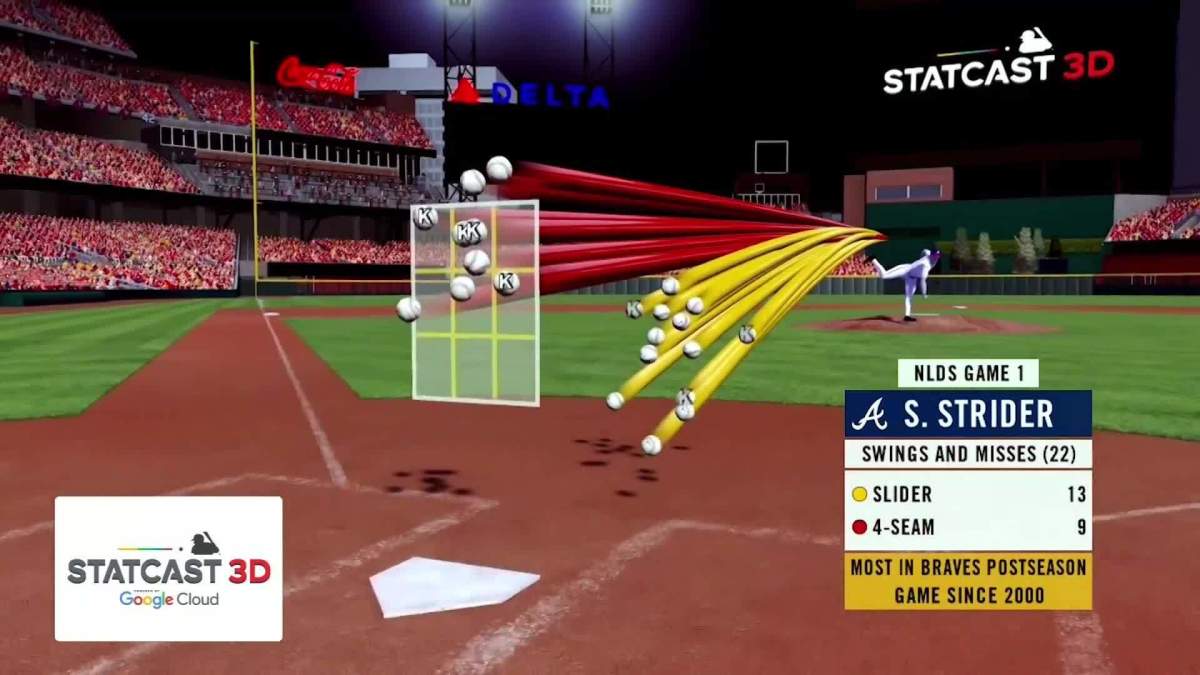How MLB Pitch Tracking Works: Behind Baseball’s Complex System

The lifespan of a major league pitch is less than half a second. If that’s difficult to conceptualize, think of the most basic, reductive metaphor for something that happens fast. Then go check the Harvard Database of Useful Biological Numbers and see that, yes, a major league fastball really does go from hand to home plate in the blink of an eye.
How does one accurately capture that?
MLB’s answer is a system of 12 cameras positioned around each ballpark, the source of the data that makes up Statcast. (The optical tracking system is the product of sports tech company Hawk-Eye, best known for making line calls in tennis.) For the last few years, there were five cameras responsible for tracking pitches at 100 frames per second and seven responsible for tracking players and batted balls at a comparatively languid 50 frames per second. But this season brought an upgrade.
We take a lot in sports for granted, but the logistics, tech and teamwork behind our favorite games and events all are fascinating. Sports Illustrated's How It Works series goes behind the scenes to find out how it all comes together.
How an F1 Track Works: Turning the Vegas Strip Into a Racetrack
How an NFL Sideline Works: Behind-the-Scenes With the Dolphins
How Building an NBA Arena Works: Inside Clippers’ New Home
How Olympic Timekeeping Works: Innovations Worth Watching
It turned out that 100 frames a second wasn’t quite enough for gathering all the information that MLB desired for Statcast. It wanted more data, faster.
So this season introduced new pitch-tracking cameras that instead capture 300 frames per second. (There are two cameras behind home plate, one by first base, one by third base and one in center field.) These create a veritable biography for each individual pitch, capturing its velocity, spin rate, seam orientation, horizontal and vertical break and more, all in that half second of life.
The results can be easy to take for granted. They’re ingrained in the game at this point: A pitch is thrown, and seemingly immediately “92-mph curveball” or “101-mph fastball” will flash on the scoreboard and TV broadcast. But the process of gathering that information is remarkably complex—and getting more so each year.
Take the camera upgrade this season. The old hardware offered plenty of detail. But there was one area where MLB felt the results were lacking. What about the exact moment the pitch crossed the plate and connected (or didn’t) with the bat? To capture 100 frames a second means losing just milliseconds between snapshots. Yet those milliseconds can be the difference between a whiff and a hit, between making good, hard contact and rolling over on a pitch. Hence the need to up the speed.

“At 100 frames a second, even, the bat moves so much between frames that you can’t get a good read on how fast the bat has moved and exactly where it is,” says Ben Jedlovec, senior director of baseball data platform product for MLB. “You have to go to that extra level of granularity, with three times the frame rate, to be able to see where the bat is and to be able to measure how fast it’s moving, when and where, and really understand that bat-and-ball collision—or lack of collision.”
Watch MLB with Fubo. Start your free trial today.
This level of detail is astounding compared to what Statcast provided even just a few years ago. When the first version of the system was rolled out in 2015, it could not provide the specific release point of a pitch; it simply assumed it based on the change in velocity. (Statcast originally used a combination of radar and cameras, none of which operated at the current speed.) But the current system takes out the need for that kind of guesswork. It provides the exact release point. It gives the spin rate and the spin axis. It even captures the orientation of the seams.
Of the hundreds of thousands of pitches thrown each season, Statcast now misses “only a handful,” Jedlovec says. The errors have gotten smaller over the past few years—mistakes of an inch or two at the plate are now less than a quarter of an inch. (It bears noting that if MLB opts to go to robo umps, it will use Hawk-Eye to make calls.) The league works with the Sports Science Lab at Washington State to conduct ground-truth testing at every ballpark to ensure the system is as accurate as possible.
The resulting data has changed the game in the most literal sense. In some cases, it’s provided a new language for age-old ideas. (Think of how any discussion of lifting the ball now involves the term “launch angle.”) In others, it’s birthed entirely new concepts, with the data responsible for advancements in pitch design and defensive alignment.
“We thought about data as a way to evaluate players,” Jedlovec says of the early days of Statcast. “We didn’t necessarily anticipate—or at least I didn’t anticipate—the way that it would ultimately shift the game.”
Perhaps the most impressive aspect of how Statcast tracks a pitch is that the data is transmitted even faster than the pitch itself. The bulk of the information is communicated and stored as the three-dimensional coordinates of the ball in every frame from every camera. (“We run a pretty high Google Cloud bill every year,” says Jedlovec.) But MLB requests a few specific pieces of data instantaneously. One of those is the speed of the ball as it leaves the pitcher’s hand. “It’s automated to the degree that in 250 milliseconds after that pitch is released, when it’s on its way to the plate, we know how fast that was and we can send it to the scoreboard,” he says.
Or put more simply? “It’s like magic.”
